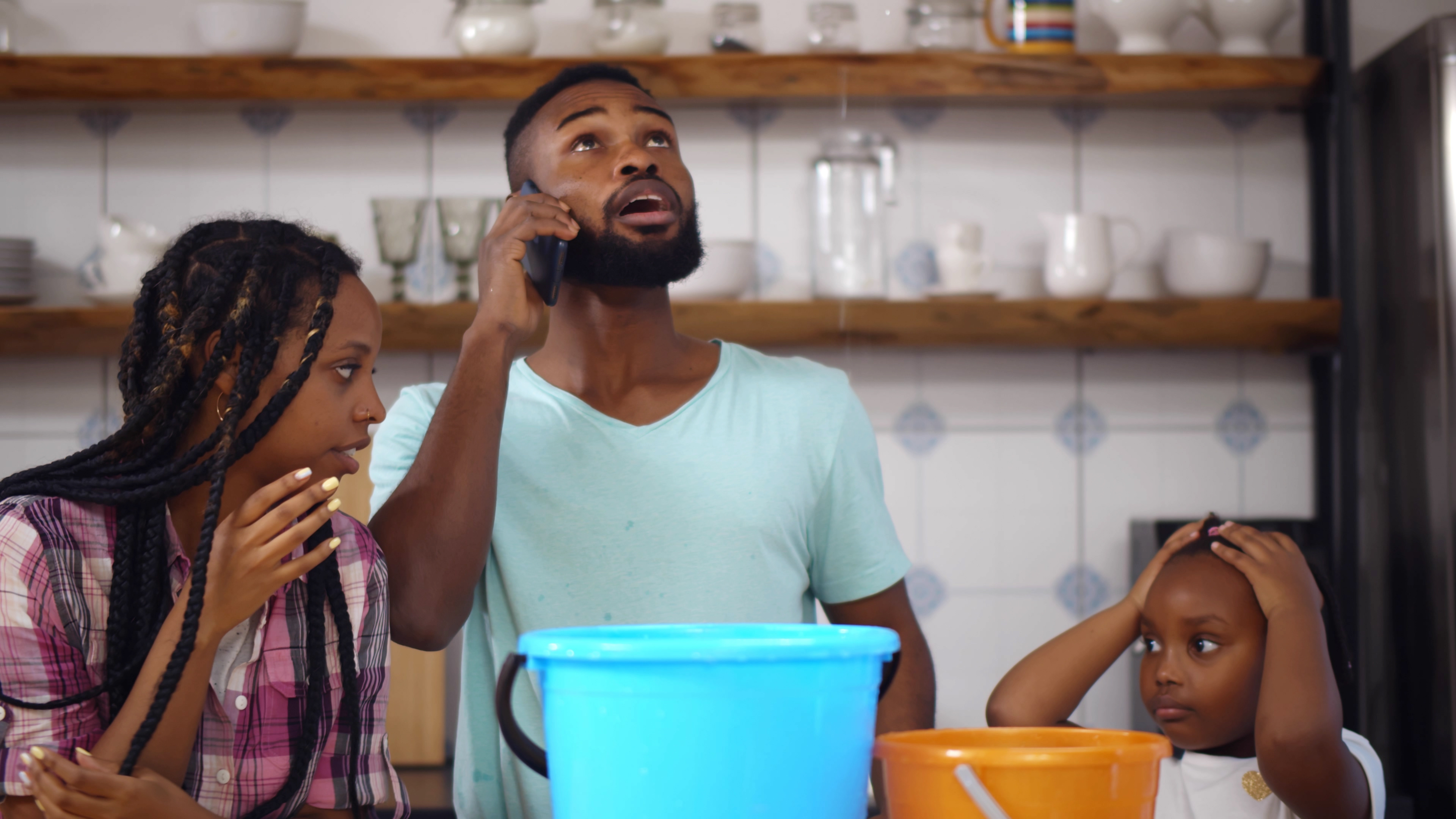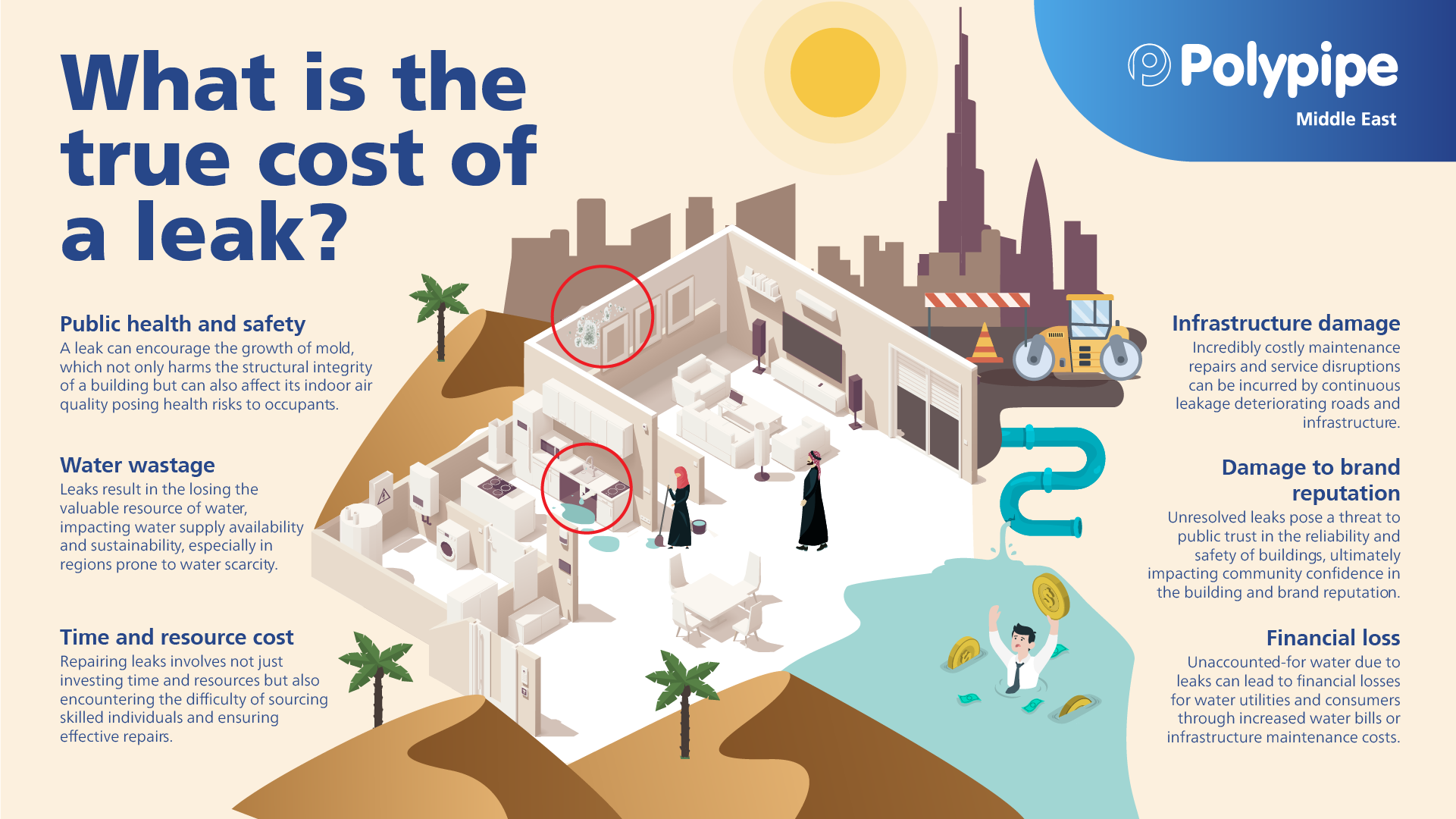From Drips to Floods: Understanding the Spectrum of Water Leaks
Tuesday 14th May 2024

Across the Middle East, water scarcity remains a pressing issue. Today, the region is home to seven of the world’s top ten most ‘water stressed’ nations, where water demand exceeds the available amount. In recent years, regional governments have taken commendable steps to mitigate this issue, including investing in technological innovation and advanced water management systems.
However, while public measures are put into place, a significant risk to water supply remains on a private scale: water leakages. According to the World Bank, leakages account for between 20% to 50% of the region’s water supply. And, in a hot, arid region where water is already in demand, wastage presents a serious problem – for the planet, for a building owner’s pocket and for the people who call those buildings home.
So, what is the true cost of a leak? How can we address – and reduce – leakages within plumbing systems? And how can we best leverage product innovation to ensure safer, more cost-efficient plumbing solutions?
Understanding the Cost of Water Leaks
The Financial Cost
When it comes to the financial cost of water leaks, an unexpectedly high utility bill can be the least of a building occupant's or owner’s worries.
Even a small, unnoticed leak can cause significant structural damage over time. Because water can seep into the minutest of cracks, a leak can ultimately affect a building’s foundations, walls and flooring, exacerbating the breakdown of building materials.
Additionally, stagnant moisture from a leak can also encourage the growth of mould, which not only harms the structural integrity of a building but can also affect its indoor air quality (IAQ). Once detected, mould often requires costly and lengthy remediation efforts to ensure its complete removal.
Another key financial risk is electrical failure. If water from an undetected leak comes in contact with electrical systems it can lead to expensive repairs to electrical wiring and fixtures, as well as significant inconvenience and safety risks for occupants.
One common cause of these leakage issues lies in the use of low-quality materials, such as those used in polypropylene random copolymer pipes (PPR) pipes. These pipes are prone to brittleness and fractures – in this respect, short-term cost-saving exercises in material selection can often lead to leaks that can devastate the core structure of a building, and end up becoming incredibly costly. In fact, when left undetected, a water leak can end up costing a singular occupant tens of thousands of dirhams for one unit alone – let alone for an entire building complex.
The Time and Resources Cost
When a leak does occur, addressing issues such as mould, structural damage, an electrical issue or simply identifying the leak’s source typically requires additional labour and often results in building downtime.
Depending on the severity and extent of the leak, the downtime necessary for addressing and repairing leaks can represent a significant cost in time and resources, particularly for businesses within a building. Operations may need to halt entirely, leading to lost productivity and revenue. Meanwhile, a building’s occupants can face significant disruptions to their daily lives – which can, ultimately, be bad for a building owner’s reputation.
Public Health Cost
However, the most significant cost consideration when it comes to leakages is the potential cost to public health.
In addition to factors such as IAQ and electrical faults, leaks from compromised piping systems, such as those made from PPR, can also lead to the contamination of potable water supplies with bacteria and mould. This is because PPR pipes contain internal fibres which ‘grab’ calcium deposits. The buildup inside these pipes creates a breeding ground for bacteria and other harmful agents, jeopardising the quality and safety of drinking water delivered to homes and exposing residents to health risks.
How to Mitigate the Risks of Water Leakage
Reducing the risk of water leaks begins with investing in quality solutions for peace of mind.
Firstly, choosing the right equipment and materials. Selecting high-quality, durable materials that can withstand long-term corrosion, degradation and deposit buildup can ensure the safety and longevity of plumbing systems, reducing the risk of leaks.
Whilst professional installation and maintenance are essential to reduce the risk of faults, it’s also important to consider the ease of use of components within a plumbing system. In certain circumstances, self-inspection and maintenance of piping and plumbing work may be necessary. By selecting components that are quick and easy to install, inspect and maintain, building owners can also reduce the time, costs and resources required for professional callouts, while ensuring that the plumbing system remains in optimal condition.
Finally, one of the most secure ways that today’s building owners can reduce the risk of water leaks is by investing in next-generation plumbing solutions. Smart plumbing solutions and water distribution systems leverage advanced technologies, such as real-time monitoring and automated leak detection alerts, to safeguard a building’s infrastructure and its inhabitants.
How Smart Plumbing Technology Can Make a Difference
Today, advancements in smart plumbing technology are transforming the ways in which we manage and maintain water systems to prevent leaks and contamination.
For example, PolyPlumb® Enhanced fitting – the latest innovation from Polypipe Middle East – is built upon 25 years of plumbing expertise and engineered for fast installation, zero risk and peace of mind.
It features new, patented In-Cert®️ feedback technology, which incorporates a 360º wave feature in its head. This engages with projections within the socket and helps to align and centralise the pipe. The haptic click of the In-Cert® technology gives additional confidence that the joint has been made.
It also features a high-performance, stainless steel grab ring and a pre-lubricated EPDM O-Ring, for superior long-term joint integrity and to minimise the risk of leaks. PolyPlumb® Enhanced is also BBA-certified and comes with a 50-year guarantee, to keep systems safer from leaks, for longer.
Although a leak may seem small and trivial, if not addressed it can cause significant long-term issues for buildings, and their occupants and owners alike. However, a new generation of products and innovations is helping to make leak protection and prevention easier than ever.
By investing in smarter plumbing solutions which prioritise pipe safety and fitting integrity, it becomes much easier to achieve a cleaner, safer better water management experience which not only results in fewer leak disruptions but also greater cost efficiency and less system downtime – and that is a true value-add to any plumbing project.
To learn more about PolyPlumb® Enhanced, visit: https://middleeast.polypipe.com/me-polyplumb.
To learn more about how Polypipe Middle East’s systems and solutions can safeguard your next project, contact us today.
Tel: +971 (0) 4 518 3000
Email: middleeast@polypipe.com

